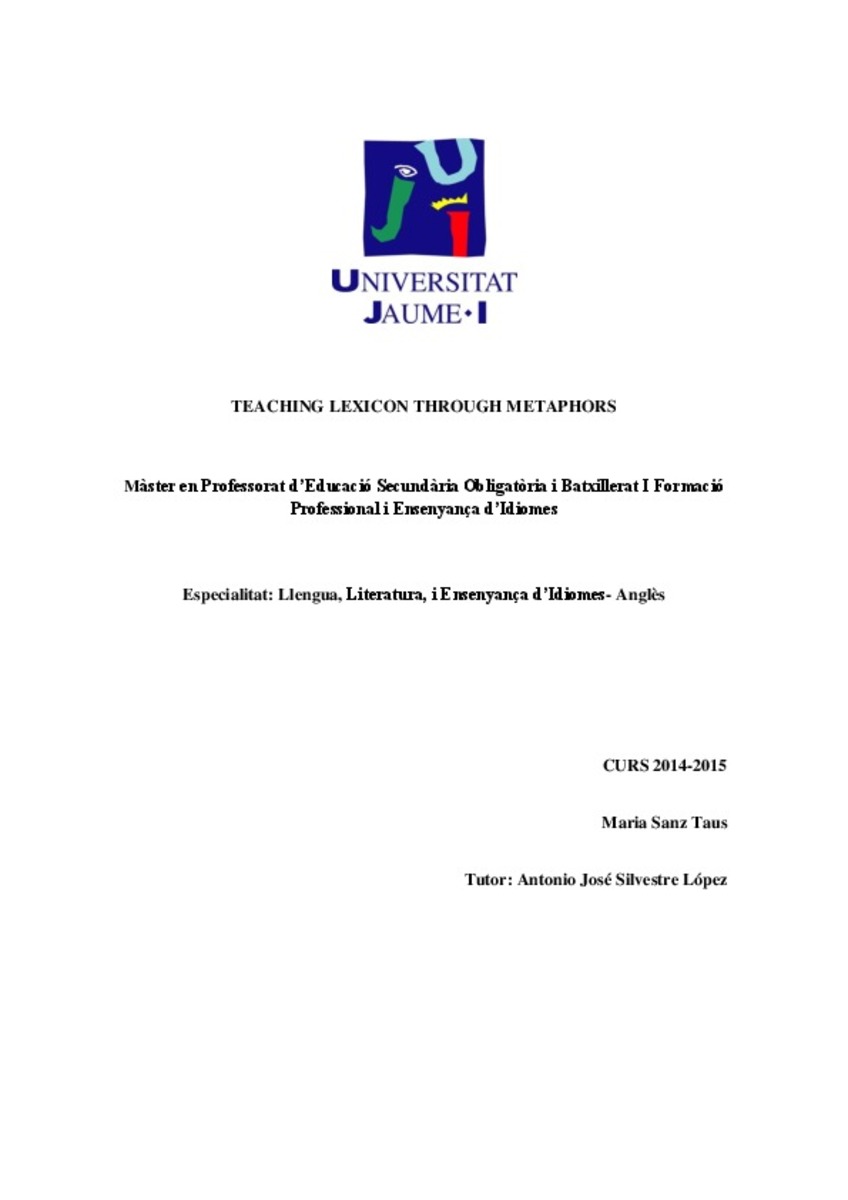Mostrar el registro sencillo del ítem
Teaching lexicon through metaphors
| dc.contributor | Silvestre López, Antonio José | |
| dc.contributor.author | Sanz Taus, María | |
| dc.contributor.other | Universitat Jaume I. Departament d'Estudis Anglesos | |
| dc.date.accessioned | 2016-01-08T12:08:18Z | |
| dc.date.available | 2016-01-08T12:08:18Z | |
| dc.date.issued | 2015-07-14 | |
| dc.identifier.uri | http://hdl.handle.net/10234/144586 | |
| dc.description | Treball final de Màster Universitari en Professor/a d'Educació Secundària Obligatòria i Batxillerat, Formació Professional i Ensenyaments d'Idiomes. Codi: SAP419. Curs acadèmic 2014-2015 | ca_CA |
| dc.description.abstract | We tend to think that metaphors are basically an embellishment of language, associating their use to the field of literature. Nevertheless, many linguists have proved that metaphors belong to our daily life and we cannot relegate them to a secondary level. They are present in our commonsense reasoning, and they are strongly related to our thought, reason and culture (Lakoff 1987; Kövecses 2002). Every language uses different associations to express concrete concepts; understanding these associations contributes to a better comprehension of a language (Kövecses 1989). This is why it is so important to improve our metaphorical competence when studying an L2. For this reason, it is in the hand of the teacher to raise consciousness on language learning from wider points of view and contemplate the idea of introducing metaphors in language learning. As many authors stand up for, that the fact of introducing conceptual metaphors in students’ learning, facilitates the acquisition of lexicon (Boers 2000, Littlemore 2010). This study tries to compare the results on the implementation of three basic emotion concepts from two different approaches: a traditional approach, and a metaphorical approach. In order to do so, I determined that working with simple emotions such as happiness, sadness and anger would be useful for the students and for my research as well. I narrowed this study by choosing two groups of students for the implementation of a pre-test, to test student’s previous knowledge, two sets of activities implemented through the two different approaches, and finally a post-test, from which results were collected. These final results helped me collecting enough data in order to determine which of the approaches was more successful and useful for learning vocabulary. In fact, the results derived from this study provide further evidence concerning the effectiveness of metaphorical approaches to the acquisition of lexicon. In sum, this study proves that, even though learners possess different learning styles, the metaphorical approach aids general vocabulary learning and improves the learners’ linguistic competence at all levels. Metaphors are an important part of language that should not be forgotten in L2 teaching. | ca_CA |
| dc.format.extent | 43 p. | ca_CA |
| dc.format.mimetype | application/pdf | ca_CA |
| dc.language.iso | eng | ca_CA |
| dc.publisher | Universitat Jaume I | ca_CA |
| dc.rights | Attribution-NonCommercial-ShareAlike 4.0 Spain | * |
| dc.rights.uri | http://creativecommons.org/licenses/by-nc-sa/4.0/ | * |
| dc.subject | Màster Universitari en Professor/a d'Educació Secundària Obligatòria i Batxillerat, Formació Professional i Ensenyaments d'Idiomes | ca_CA |
| dc.subject | Máster Universitario en Profesor/a de Educación Secundaria Obligatoria y Bachillerato, Formación Profesional y Enseñanzas de Idiomas | ca_CA |
| dc.subject | Master's Degree in Secondary Education, Vocational Training and Language Teaching | ca_CA |
| dc.title | Teaching lexicon through metaphors | ca_CA |
| dc.type | info:eu-repo/semantics/masterThesis | ca_CA |
| dc.educationLevel | Estudios de Postgrado | ca_CA |
| dc.rights.accessRights | info:eu-repo/semantics/openAccess | ca_CA |
Ficheros en el ítem
Este ítem aparece en la(s) siguiente(s) colección(ones)
-
TFM: Màster Universitari en Professor/a d'Educació Secundària Obligatòria i Batxillerat, Formació Professional i Ensenyaments d'Idiomes [1230]
SAP118, SAP119, SAP128, SAP129, SAP138, SAP139, SAP218, SAP219, SAP228,SAP229, SAP238, SAP239, SAP319, SAP419, SAP429, SAP509, SAP909, SAP709, SAP809








